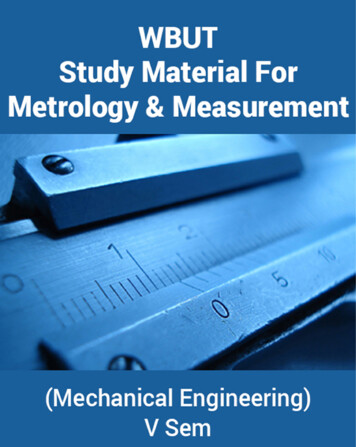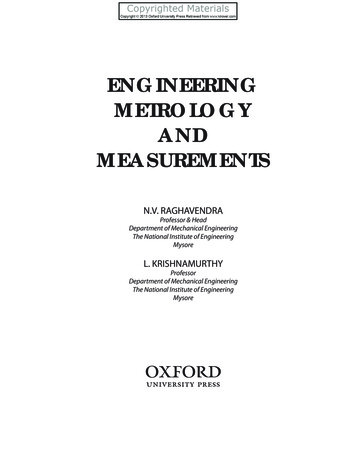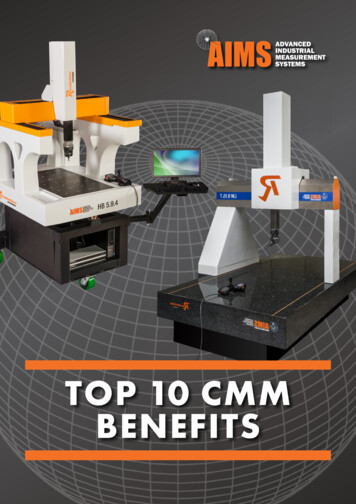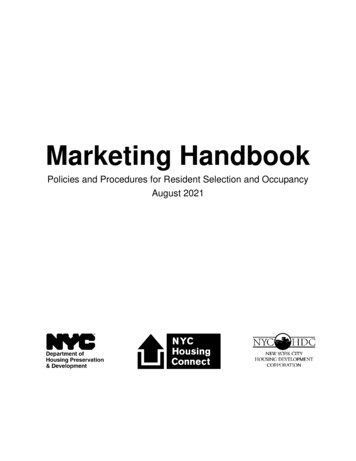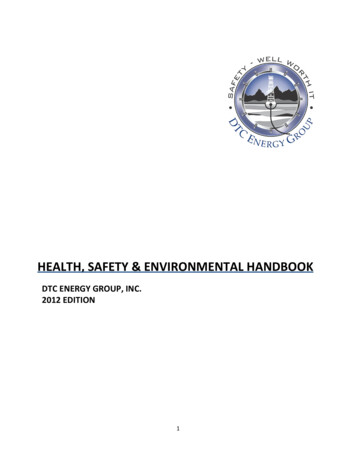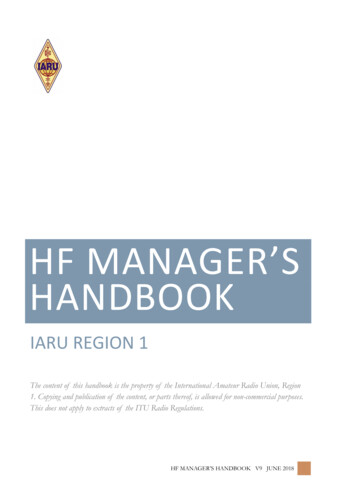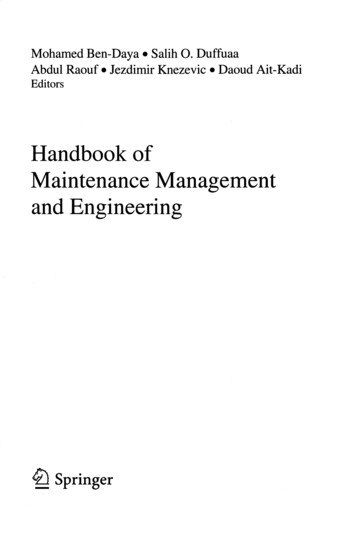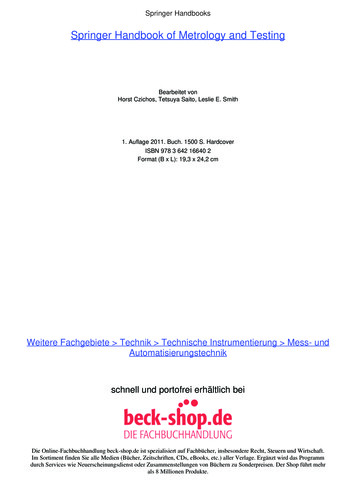
Transcription
Springer HandbooksSpringer Handbook of Metrology and TestingBearbeitet vonHorst Czichos, Tetsuya Saito, Leslie E. Smith1. Auflage 2011. Buch. 1500 S. HardcoverISBN 978 3 642 16640 2Format (B x L): 19,3 x 24,2 cmWeitere Fachgebiete Technik Technische Instrumentierung Mess- undAutomatisierungstechnikschnell und portofrei erhältlich beiDie Online-Fachbuchhandlung beck-shop.de ist spezialisiert auf Fachbücher, insbesondere Recht, Steuern und Wirtschaft.Im Sortiment finden Sie alle Medien (Bücher, Zeitschriften, CDs, eBooks, etc.) aller Verlage. Ergänzt wird das Programmdurch Services wie Neuerscheinungsdienst oder Zusammenstellungen von Büchern zu Sonderpreisen. Der Shop führt mehrals 8 Millionen Produkte.
11.1.3This chapter reviews the methodologies of measurement and testing. It gives an overview ofmetrology and presents the fundamentals ofmaterials characterization as a basis for1. Chemical and microstructural analysis2. Materials properties measurement3. Materials performance testingConformity Assessmentand Accreditation.51.2Overview of Metrology .1.2.1 The Meter Convention .1.2.2 Categories of Metrology.1.2.3 Metrological Units .1.2.4 Measurement Standards .7779101.3Fundamentalsof Materials Characterization .1.3.1 Nature of Materials.1.3.2 Types of Materials .1.3.3 Scale of Materials .1.3.4 Properties of Materials .1.3.5 Performance of Materials .1.3.6 Metrology of Materials .11111314151718References .20which are treated in parts B, C, and D of thehandbook.1.1Methodologies of Measurementand Testing.1.1.1 Measurement .1.1.2 Testing.113In science and engineering, objects of interest have tobe characterized by measurement and testing. Measurement is the process of experimentally obtaining quantityvalues that can reasonably be attributed to a property ofa body or substance. Metrology is the science of measurement. Testing is the technical procedure consistingof the determination of characteristics of a given objector process, in accordance with a specified method [1.1].1.1 Methodologies of Measurement and TestingThe methodologies of measurement and testing to determine characteristics of a given object are illustrated ina unified general scheme in Fig. 1.1, which is discussedin the next sections.1.1.1 MeasurementMeasurement begins with the definition of the measurand, the quantity intended to be measured. Thespecification of a measurand requires knowledge of thekind of quantity and a description of the object carrying the quantity. When the measurand is defined, itmust be related to a measurement standard, the realization of the definition of the quantity to be measured.The measurement procedure is a detailed descriptionof a measurement according to a measurement principle and to a given measurement method. It is basedon a measurement model, including any calculationto obtain a measurement result. The basic features ofa measurement procedure are the following [1.1]. Measurement principle: the phenomenon serving asa basis of a measurementMeasurement method: a generic description ofa logical organization of operations used in a measurementMeasuring system: a set of one or more measuring instruments and often other devices, includingany reagent and supply, assembled and adapted togive information used to generate measured quan-Part A 1Introduction t1. Introduction to Metrology and Testing
2Part AFundamentals of Metrology and TestingPart A 1.1OBJECTSI andardCalibrationMeasurandMeasurement procedureTesting procedureMeasurement principleMeasurement methodMeasuring systemMeasurement uncertaintyTest principleTest methodInstrumentationQuality assuranceChemical composition,geometry, structure,physical properties,engineering properties,otherReference procedureTesting result: Specified characteristic of anobject by qualitative and quantitative means,and adequately estimated uncertaintiesMeasurement result:Quantity value1 uncertainty (unit)Fig. 1.1 The methodologies of measurement (white) and testing (brown) – a general schemetity values within specified intervals for quantitiesof specified kindsBIPMBureau International desPoids et MésuresNational metrologyinstitutes or designatednational institutesNationalprimarystandardsCalibration laboratories,often accreditedReference standardsIndustry, academia,regulators, hospitalsWorking standardsEnd usersMeasurementsFig. 1.2 The traceability chain for measurementsMeasurement uncertainty: a nonnegative parametercharacterizing the dispersion of the quantity valuesbeing attributed to a measurandThe result of a measurement has to be expressed asa quantity value together with its uncertainty, includingthe unit of the measurand.Definitionof the unitForeignnational primarystandards Traceability and CalibrationThe measured quantity value must be related to a reference through a documented unbroken traceabilitychain. The traceability of measurement is described indetail in Sect. 3.2. Figure 1.2 illustrates this conceptschematically.The traceability chain ensures that a measurementresult or the value of a standard is related to referencesat the higher levels, ending at the primary standard,based on the International System of Units (le Système International d’Unités, SI) (Sect. 1.2.3). An enduser may obtain traceability to the highest international level either directly from a national metrologyinstitute or from a secondary calibration laboratory, usually an accredited laboratory. As a result of variousmutual recognition arrangements, internationally recognized traceability may be obtained from laboratoriesoutside the user’s own country. Metrological timelinesin traceability, defined as changes, however slight, in
Introduction to Metrology and TestingUncertainty of MeasurementsMeasurement uncertainty comprises, in general, manycomponents and can be determined in differentways [1.3]. The Statistical Evaluation of Results is explained in detail in Sect. 3.3, and the Accuracy andUncertainty of Measurement is comprehensively described in Sect. 3.4. A basic method to determineuncertainty of measurements is the Guide to the expression of uncertainty in measurement (GUM) [1.4], whichis shared jointly by the Joint Committee for Guidesin Metrology (JCGM) member organizations (BIPM,IEC, IFCC, ILAC, ISO, IUPAC, IUPAP and OIML).The concept of the GUM can be briefly outlined asfollows [1.5].The GUM Uncertainty Philosophy. A measurement quantity X, whose value is notknown exactly, is considered as a stochastic variablewith a probability function.The result x of measurement is an estimate of theexpectation value E(X). The standard uncertainty u(x) is equal to the squareroot of an estimate of the variance V (X).Type A uncertainty evaluation. Expectation andvariance are estimated by statistical processing ofrepeated measurements.Type B uncertainty evaluation. Expectation andvariance are estimated by other methods than thoseused for type A evaluations. The most commonlyused method is to assume a probability distribution,e.g., a rectangular distribution, based on experienceor other information.The GUM Method Based on the GUM Philosophy. Identify all important components of measurementuncertainty. There are many sources that can contribute to measurement uncertainty. Apply a modelof the actual measurement process to identify thesources. Use measurement quantities in a mathematical model.Calculate the standard uncertainty of each component of measurement uncertainty. Each componentof measurement uncertainty is expressed in termsof the standard uncertainty determined from eithera type A or type B evaluation.Calculate the combined uncertainty u (the uncertainty budget). The combined uncertainty iscalculated by combining the individual uncertaintycomponents according to the law of propagation ofuncertainty. In practice– for a sum or a difference of components, thecombined uncertainty is calculated as the squareroot of the sum of the squared standard uncertainties of the components;– for a product or a quotient of components, thesame sum/difference rule applies as for the relative standard uncertainties of the components.Calculate the expanded uncertainty U by multiplying the combined uncertainty with the coveragefactor k.State the measurement result in the form X x U.The methods to determine uncertainties are presented in detail in Sect. 3.4.1.1.2 TestingThe aim of testing is to determine characteristics(attributes) of a given object and express them by qualitative and quantitative means, including adequately3Part A 1.1all instruments and standards over time, are discussedin [1.2].A basic tool in ensuring the traceability of a measurement is either the calibration of a measuringinstrument or system, or through the use of a reference material. Calibration determines the performancecharacteristics of an instrument or system before itsuse, while reference material calibrates the instrument or system at time of use. Calibration is usuallyachieved by means of a direct comparison againstmeasurement standards or certified reference materialsand is documented by a calibration certificate for theinstrument.The expression “traceability to the SI” means traceability of a measured quantity value to a unit of theInternational System of Units. This means metrological traceability to a dematerialized reference, becausethe SI units are conceptually based on natural constants, e.g., the speed of light for the unit of length.So, as already mentioned and shown in Fig. 1.1, thecharacterization of the measurand must be realized bya measurement standard (Sect. 1.2.4). If a measuredquantity value is an attribute of a materialized object(e.g., a chemical substance, a material specimen ora manufactured product), also an object-related traceability (speciation) to a materialized reference (Fig. 1.1)is needed to characterize the object that bears the metrologically defined and measured quantity value.1.1 Methodologies of Measurement and Testing
Part AFundamentals of Metrology and TestingPart A 1.1estimated uncertainties, as outlined in the right-handside of Fig. 1.1. For the testing methodology, metrology delivers the basis for the comparability of testresults, e.g., by defining the units of measurement andthe associated uncertainty of the measurement results.Essential tools supporting testing include referencematerials, certified reference materials, and referenceprocedures. Reference material (RM) [1.6]: a material, sufficiently homogeneous and stable with regards tospecified properties, which has been established tobe fit for its intended use in measurement or in examination of nominal propertiesCertified reference material (CRM): a reference material, accompanied by documentation issued by anauthoritative body and providing one or more specified property values with associated uncertaintiesand traceabilities, using a valid procedureReference procedures [1.5]: procedures of testing,measurement or analysis, thoroughly characterizedand proven to be under control, intended for– quality assessment of other procedures for comparable tasks, or– characterization of reference materials includingreference objects, or– determination of reference values.The uncertainty of the results of a reference procedure must be adequately estimated and appropriate forthe intended use. Recommendations/guides for the de-Loadingtension, compression,bending, shear, torsion,- static force F, or- dynamic force FReference procedure,e.g. tensile test- uniaxial stress- linear-elastic deformation- alignment of sampleaxis and F-vectortermination of uncertainties in different areas of testinginclude Guide for the estimation of measurement uncertainty in testing [1.7]Guide to the evaluation of measurement uncertaintyfor quantitative tests results [1.8]Guide for chemistry [1.9]Measurement uncertainty in environmental laboratories [1.10]Uncertainties in calibration and testing [1.11].The methodology of testing combined with measurement is exemplified in Fig. 1.3 for the determinationof mechanical characteristics of a technical object.Generally speaking, the mechanical properties ofmaterials characterize the response of a material sampleto loading. The mechanical loading action on materials in engineering applications can basically becategorized as tension, compression, bending, shearor torsion, which may be static or dynamic. In addition, thermomechanical loading effects can occur. Thetesting of mechanical properties consists of measuring the mechanical loading stress (force/cross-sectionalarea F/A) and the corresponding materials response(strain, elongation) and expressing this as a stress–strain curve. Its regimes and data points characterize themechanical behavior of materials.Consider for example elasticity, which is an important characteristic of all components of engineeredstructures. The elastic modulus (E) describes the rela-Technical objectMaterial sample:geometry, dimensionsStress, straincomposition microstructureReferencematerialMeasurands- load force F- sample length I- reference temperature TSI (K)Stress–strain curve (static loading)Strength Fmax/A0Stress σ F/A4PlasticityFractureElasticityE σ/εStrain:ε Δl/l0Measurement standards(calibrated)Load cellmassesSI (kg)Extensiometergage blocksSI (m)Fig. 1.3 The combination of measurement and testing to determine mechanical characteristics of the technical object
Introduction to Metrology and Testing Metrologically, the measurands of the strength valueare the force (F), area (A), and the length measurement (l) of the technical object, all at a referencetemperature (T ).Technologically and concerning testing, the mechanical characteristics expressed in a stress–straincurve depend on at least the following groups ofinfluencing parameters, to be backed up by appropriate references.– The chemical and physical nature of the object: chemical composition, microstructure, andstructure–property relations such as crystallographic shape-memory effects [1.12]; for example, strength values of metals are significantlyinfluenced by alloying elements, grain size(fine/coarse), work-hardening treatment, etc.– The mechanical loading action and dependenceon deformation amplitude: tension, compression, bending, shear, and torsion; for example,tensile strength is different from shear strengthfor a given material.– The time dependence of the loading mode forces(static, dynamic, impact, stochastic) and deviations from simple linear-elastic deformation(anelastic, viscoelastic or micro-viscoplastic deformation). Generally, the dynamic strengthof a material is different from its staticstrength.The combined measurement and testing methodologies, their operating parameters, and the traceabilityrequirements are illustrated in a highly simplifiedscheme by the confidence ring [1.13] shown in Fig. 1.4.The confidenceringTraceable inpute.g. loadTraceable responsee.g. displacementMaterialresponse PropertyProceduralaspectse.g. alignment5Part A 1.1tion between a stress (σ) imposed on a material andthe strain (ε) response of the material, or vice versa.The stimulus takes the form of an applied load, andthe measured effect is the resultant displacement. Thetraceability of the stress is established through the useof a calibrated load cell and by measuring the specimen cross-sectional area with a calibrated micrometer,whereas the traceability of the strain is established bymeasuring the change in length of the originally measured gage length, usually with a calibrated strain gage.This, however, is not sufficient to ensure repeatableresults unless a testing reference procedure, e.g., a standardized tensile test, is used on identically preparedspecimens, backed up by a reference material.Figure 1.3 illustrates the metrological and technological aspects.1.1 Methodologies of Measurement and TestingTraceable materialcharacterizatione.g. scale (grain size),quality (porosity)Reference temperatureFig. 1.4 Confidence ring for material property combined measurement and testing – note that separate traceability requirements applyto applied stimulus (load), response (displacement), and materialcharacterization (grain size, porosity)The confidence ring illustrates that, in measurementand testing, it is generally essential to establish reliabletraceability for the applied stimulus and the resultingmeasured effect as well as for the measurements ofany other quantities that may influence the final result.The final result may also be affected by the measurement procedure, by temperature, and by the state ofthe sample. It is important to understand that variation in measured results will often reflect materialinhomogeneity as well as uncertainties associated withthe test method or operator variability. All uncertainties should be taken into account in an uncertaintybudget.1.1.3 Conformity Assessmentand AccreditationIn today’s global market and world trade there is anincreased need for conformity assessment to ensurethat products and equipment meet specifications. Thebasis for conformity assessment are measurements together with methods of calibration, testing, inspection,and certification. The goal of conformity assessment
6Part AFundamentals of Metrology and TestingPart A 1.1Table 1.1 Standards of conformity assessment toolsTools for conformityassessmentFirst partySupplier, userSupplier’s declarationCalibration, testingInspectionCertification Second partyCustomers,trade associations,regulatorsThird partyBodies independentfrom 1st and2nd parties is to provide the user, purchaser or regulator with thenecessary confidence that a product, service, process,system or person meets relevant requirements. Theinternational standards relevant for conformity assessment services are provided by the ISO Committee onConformity Assessment (CASCO). The conformity assessment tools are listed in Table 1.1, where their useby first parties (suppliers), second parties (customers,regulators, trade organizations), and third parties (bodies independent from both suppliers and customers) isindicated.Along with the growing use of these conformityassessment tools there is the request for assurance ofthe competence of the conformity assessment bodiesISO standardsISO/IEC 17050ISO/IEC 17025ISO/IEC 17020ISO 17021ISO Guide 65(CABs). An increasingly applied and recognized toolfor this assurance is accreditation of CABs.The world’s principal international forum for thedevelopment of laboratory accreditation practices andprocedures is the International Laboratory Accreditation Cooperation (ILAC, http://www.ilac.org/). Itpromotes laboratory accreditation as a trade facilitationtool together with the recognition of competent calibration and testing facilities around the globe. ILACstarted as a conference in 1977 and became a formal cooperation in 1996. In 2000, 36 ILAC memberssigned the ILAC Mutual Recognition Arrangement(MRA), and by 2008 the number of members of theILAC MRA had risen to 60. Through the evaluationMarket, rsproducts, gtradeRequirementsConformity assessment service:The process for determining whether products, processes,systems or people meet specified requirementsConformity assessment ands s,trade organizationsAccreditation serviceassures the competence of the conformity assessment bodiesAccreditation bodiesDemands for competent accreditationof conformity assessment bodiesFig. 1.5 Interrelations between market, trade, conformity assessment, and accreditation
Introduction to Metrology and Testing(WTO) Technical Barriers to Trade agreement. Anoverview of the interrelations between market, trade,conformity assessment, and accreditation is shown inFig. 1.5.1.2 Overview of MetrologyHaving considered the methodologies of measurementand testing, a short general overview of metrology isgiven, based on Metrology – in short [1.5], a brochurepublished by EURAMET to establish a common metrological frame of reference.1.2.1 The Meter ConventionIn the middle of the 19th century the need for a worldwide decimal metric system became very apparent,particularly during the first universal industrial exhibitions. In 1875, a diplomatic conference on the metertook place in Paris, at which 17 governments signed thediplomatic treaty the Meter Convention. The signatoriesdecided to create and finance a permanent scientific institute: the Bureau International des Poids et Mesures(BIPM). The Meter Convention, slightly modified in1921, remains the basis of all international agreementon units of measurement. Figure 1.6 provides a briefoverview of the Meter Convention Organization (detailsare described in Chap. 2).1.2.2 Categories of MetrologyMetrology covers three main areas of activities [1.5].1. The definition of internationally accepted units ofmeasurementThe Meter Conventioninternational convention established in 1875 with 54 member states in 2010CGPM Conférence Générale des Poids et MésuresCommittee with representatives from the Meter Conventionmember states. First conference held in 1889 and meets every4th year. Approves and updates the SI system with results fromfundamental metrological research.National Metrology InstitutesNMIs developand maintain nationalmeasurement standards,represent the countryinternationally in relation toother national metrologyinstitutes and to the BIPM.A NMI or its nationalgovernment may appointdesignated institutes inthe country to hold specificnational standards.CIPM Comité Internationale des Poids et MésuresCommittee with up to 18 representatives from CGPM.Supervises BIPM and supplies chairmen for the ConsultativeCommittees (CC).BIPM BureauInternational desPoids et MésuresInternational research inphysicals units andstandards. Administrationof interlaboratorycomparisons of thenational metrologyinstitutes (NMI) anddesignated laboratories.Consultative CommitteesAUV Acoustics, ultrasound, vibrationEM Electricity and magnetismLengthLMass and related quantitiesMPR Photometry and radiometryQM Amount of substanceIonizing radiationRIThermometryTTF Time and frequencyUnits.UFig. 1.6 The organizations and their relationships associated with the Meter ConventionCIPM MRA (signed 1999)Mutual recognition arrangement between NMIs toestablish equivalence ofnational NMI measurementstandards and to providemutual recognition of theNMI calibration andmeasurement certificates.7Part A 1.2of the participating accreditation bodies, the international acceptance of test data and the elimination oftechnical barriers to trade are enhanced as recommended and in support of the World Trade Organization1.2 Overview of Metrology
8Part AFundamentals of Metrology and TestingPart A 1.22. The realization of units of measurement by scientificmethods3. The establishment of traceability chains by determining and documenting the value and accuracy ofa measurement and disseminating that knowledgeMetrology is separated into three categories withdifferent levels of complexity and accuracy (for details,see Chaps. 2 and 3).Scientific MetrologyScientific metrology deals with the organization anddevelopment of measurement standards and their maintenance. Fundamental metrology has no internationaldefinition, but it generally signifies the highest level ofaccuracy within a given field. Fundamental metrologymay therefore be described as the top-level branch ofscientific metrology.Scientific metrology is categorized by BIPM intonine technical subject fields with different branches.The metrological calibration and measurement capabilities (CMCs) of the national metrology institutes(NIMs) and the designated institutes (DIs) are compiledtogether with key comparisons in the BIPM key comparison database (KCDB, http://kcdb.bipm.org/). AllCMCs have undergone a process of peer evaluationby NMI experts under the supervision of the regionalmetrology organizations (RMOs). Table 1.2 shows thescientific metrology fields and their branches togetherwith the number of registered calibration and measurement capabilities (CMCs) of the NMIs in 2010.Industrial MetrologyIndustrial metrology has to ensure the adequate functioning of measurement instruments used in industrialproduction and in testing processes. Systematic measurement with known degrees of uncertainty is one ofthe foundations of industrial quality control. Generallyspeaking, in most modern industries the costs bound upin taking measurements constitute 10–15% of production costs.However, good measurements can significantly increase the value, effectiveness, and quality of a product.Thus, metrological activities, including calibration, testing, and measurements, are valuable inputs to ensure thequality of most industrial processes and quality of liferelated activities and processes. This includes the needto demonstrate traceability to international standards,which is becoming just as important as the measurementitself. Recognition of metrological competence at eachlevel of the traceability chain can be established throughmutual recognition agreements or arrangements, as wellas through accreditation and peer review.Legal MetrologyLegal metrology originated from the need to ensurefair trade, specifically in the area of weights and measures. The main objective of legal metrology is to assurecitizens of correct measurement results when used in official and commercial transactions. Legally controlledinstruments should guarantee correct measurement results throughout the whole period of use under workingconditions, within given permissible errors.Table 1.2 Metrology areas and their branches, together with the numbers of metrological calibration and measurementcapabilities (CMCs) of the national metrology institutes and designated institutes in the BIPM KCDB as of 2010Metrology areaBranchCMCsAcoustics, ultrasound, vibrationsElectricity and magnetismSound in air; sound in water; vibrationDC voltage, current, and resistance; impedance up to the megahertz range;AC voltage, current, and power; high voltage and current;other DC and low-frequency measurements; electric and magnetic fields;radiofrequency measurementsLaser; dimensional metrologyMass; density; pressure; force; torque, viscosity, hardness and gravity; fluid flowPhotometry; properties of detectors and sources; spectral properties; color;fiber opticsList of 16 amount-of-substance categoriesDosimetry; radioactivity; neutron measurementsTemperature; humidity; thermophysical quantitiesTime scale difference; frequency; time interval9556586LengthMass and related quantitiesPhotometry and radiometryAmount of substanceIonizing radiationThermometryTime and frequency116426091044455839831393586
Introduction to Metrology and Testing1. Water meters2. Gas meters3. Electrical energy meters and measurement transformers4. Heat meters5. Measuring systems for liquids other than water6. Weighing instruments7. Taximeters8. Material measures9. Dimensional measuring systems10. Exhaust gas analyzersMember states of the European Union have the option to decide which of the instrument types they wishto regulate.The International Organization of Legal Metrology(OIML) is an intergovernmental treaty organization established in 1955 on the basis of a convention, whichwas modified in 1968. In the year 2010, OIML wascomposed of 57 member countries and an additional58 (corresponding) member countries that joined theOIML (http://www.oiml.org/) as observers. The purpose of OIML is to promote global harmonization oflegal metrology procedures. The OIML has developeda worldwide technical structure that provides its members with metrological guidelines for the elaborationof national and regional requirements concerning themanufacture and use of measuring instruments for legalmetrology applications.1.2.3 Metrological UnitsThe idea behind the metric system – a system of unitsbased on the meter and the kilogram – arose during theFrench Revolution when two platinum artefact reference standards for the meter and the kilogram were constructed and deposited in the French National Archivesin Paris in 1799 – later to be known as the Meter ofthe Archives and the Kilogram of the Archives. TheFrench Academy of Science was commissioned by theNational Assembly to design a new system of units foruse throughout the world, and in 1946 the MKSA system (meter, kilogram, second, Ampere) was acceptedby the Meter Convention countries. The MKSA was extended in 1954 to include the Kelvin and candela. Thesystem then assumed the name the International Systemof Units (Le Système International d’Unités, SI). TheSI system was established in 1960 by the 11th GeneralConference on Weights and Measures (CGPM): The International System of Units (SI) is the coherent systemof units adopted and recommended by the CGPM.At the 14th CGPM in 1971 the SI was again extended by the addition of the mole as base unit foramount of substance. The SI system is now comprisedof seven base units, which together with derived unitsmake up a coherent system of units [1.5], as shown inTable 1.3.Table 1.3 The SI base unitsQuantityBase condkgsElectric currentAmpereATemperatureKelvinKAmount of substanceMolemolLuminous intensityCandelacdThe meter is the length of the path traveled by light in a vacuum during a time intervalof 1/299 792 458 of a secondThe kilogram is equal to the mass of the international prototype of the kilogramThe second is the duration of 9 192 631 770 periods of t
Springer Handbook of Metrology and Testing Bearbeitet von Horst Czichos, Tetsuya Saito, Leslie E. Smith 1. Auflage 2011. Buch. 1500 S. Hardcover ISBN 978 3 642 16640 2 Format (B x L): 19,3 x 24,2 cm Weitere Fachgebiete Technik Technische Instrumentierung Mess- und Aut
